- Historical Context of Impressionists and Photography
- Impressionism Techniques Influenced by Photography
- Key Examples and Artists of Impressionism and Photography
- Edgar Degas and Photography
- Claude Monet and Photography
- Berthe Morisot and Photography
- Mary Cassatt and Photography
- Alfred Sisley and Photography
- Camille Pissarro and Photography
- Gustave Caillebotte and Photography
- Édouard Manet and Photography
- Jean-François Raffaëlli and Photography
- Pierre-Auguste Renoir and Photography
- Visually Comparing Impressionism to Photography
- Broader Impact of Photography on Art
- Impact of Photography on Techniques and Composition
- Continuing Influence of Photography
- Sources
- Quick Facts and FAQ
Photography shook up the art world for the Impressionists.
This new technology gave artists a way to capture real life, inspiring them to explore light, movement, and everyday scenes in fresh ways. They started using candid compositions and dynamic perspectives, bringing a sense of spontaneity to their paintings. Imagine the thrill of freezing a moment in time and then translating that into paint.
This post dives into how photography influenced Impressionist techniques and subjects, transforming their approach to art. You’ll see how it made their work more immediate and relatable, pushing the boundaries of artistic expression.
Get ready to uncover the fascinating relationship between these two groundbreaking visual arts and see how they shaped a new artistic vision.

Historical Context of Impressionists and Photography
Evolution of Photography
Photography began with the invention of the daguerreotype in 1839, a process that created detailed images on silvered copper plates. This early method was soon followed by advancements like the calotype and collodion processes, which allowed for multiple copies and shorter exposure times.

By the mid-19th century, photographers could capture clearer, faster, and more reproducible images. This technological progress made photography increasingly popular and accessible, changing the way people documented and perceived the world around them.
As the 19th century progressed, photography’s appeal grew exponentially.
Photographic studios popped up in major cities, and the technology became a household fascination. It was during this period that photography started to influence other art forms. The ability to capture real-life moments and scenes with precision had a profound impact on artists, who began to see new possibilities for their own work.

Impressionism’s Emergence
ImpressionismImpressionism was an art movement of the 19th century developed in France, based on the practice of painting spontaneously out-doors (“en plein air”) rather than in the studio. Key impressionist subjects were everyday scenes and landscapes, in which the momentary and transient effects of sunlight should be captured. The artists worked directly in front of their subjects, using rapid brushwork More emerged in the late 19th century as a response to the rigid constraints of academic art.
Artists like Claude MonetFrench painter Claude Monet (1840 – 1926) was a key figure of the impressionist movement which started in the second half of the 19th century. During his long career, Monet focused on depicting leisure activities and plein air landscape painting. Born in Paris, his family moved to Le Havre in Normandy when Claude was 5 years old. From early on, More, Pierre-Auguste RenoirPierre-Auguste Renoir (1841 – 1919) is one of the last representatives of a tradition that runs directly from Rubens to Watteau. The French artist was a leading painter of the Impressionist art movement, famed for depicting female beauty and charming scenes. Coming from humble beginnings, he became an apprentice to a porcelain painter where he learned to copy designs and More, and Edgar Degas sought to capture the fleeting effects of light and color in their work. They often painted en plein airThe French term “en plein air” means “out-doors”. Plein air painting therefore refers to the practice of painting an entire finished picture out of doors. Artists have long worked out of doors to create landscape sketches for the preparation of further studio work. The plein air approach, finishing entire pictures out-doors, however, began only in the 19th century, initiated by More (outdoors) to directly observe nature and its changing qualities. This movement focused on everyday scenes, landscapes, and moments of contemporary life, breaking away from the historical and mythological subjects favored by traditional academic paintingPainting is a fundamental form of visual art that has been practiced for thousands of years. It involves applying pigment to a surface such as canvas, paper, or a wall. Painting can be explored through various styles, techniques, and mediums, each offering unique possibilities for expression and creativity. Historical Background • Ancient Beginnings: The history of painting dates back to More.
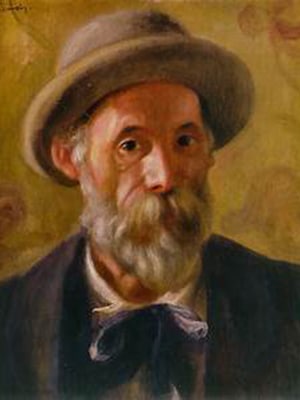
The rise of photography coincided with the emergence of ImpressionismImpressionism was an art movement of the 19th century developed in France, based on the practice of painting spontaneously out-doors (“en plein air”) rather than in the studio. Key impressionist subjects were everyday scenes and landscapes, in which the momentary and transient effects of sunlight should be captured. The artists worked directly in front of their subjects, using rapid brushwork More, creating a symbiotic relationship between the two.
The photographic emphasis on capturing a moment in time influenced Impressionists to explore similar themes in their paintings. They adopted photographic techniques such as unusual perspectives, cropping, and an emphasis on light and movement.
This intersection of photography and paintingPainting is a fundamental form of visual art that has been practiced for thousands of years. It involves applying pigment to a surface such as canvas, paper, or a wall. Painting can be explored through various styles, techniques, and mediums, each offering unique possibilities for expression and creativity. Historical Background • Ancient Beginnings: The history of painting dates back to More pushed Impressionists to innovate, resulting in artworks that were dynamic, immediate, and reflective of the modern experience.

Impressionism Techniques Influenced by Photography
Cropping and Framing in Impressionism
Photography introduced new ways of composing images, focusing on elements that might traditionally be left out. Impressionists embraced these techniques, cropping scenes to create intimate and dynamic compositions.
For example, Degas’ paintings often mimic the framing of a photograph, capturing dancers and everyday moments from unexpected angles. This approach brought a sense of immediacy and realismRealism is an art movement that emerged in the mid-19th century, emphasizing the depiction of subjects as they appear in everyday life. It rejects the idealized forms and dramatic expressions of Romanticism, focusing instead on accuracy, truthfulness, and the mundane aspects of the human experience. Realism strives to capture the world in a straightforward and unembellished manner. Gustave Courbet, The More to their work.
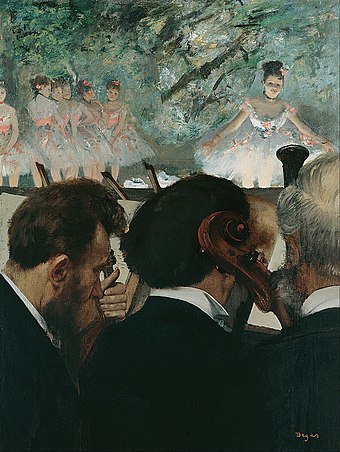
Capturing Light and Movement in Impressionism
Photography’s ability to freeze moments in time allowed artists to study light and motion in ways previously impossible. Impressionists adopted this, using loose brushstrokes to convey the flickering play of light and the fluidity of movement.
Monet’s water lilies and Degas’ racehorses are prime examples, where the depiction of light and motion adds a dynamic quality to their paintings.

Asymmetry and Spontaneity in Impressionism
The candid nature of photography influenced Impressionists to embrace asymmetrical compositions and spontaneous moments. They moved away from the balanced, symmetrical compositions of classical art.
Paintings like Renoir’s “Le Moulin de la Galette” show people in mid-action, creating a lively and informal atmosphere. This approach helped convey the energy and authenticity of everyday life, making their art feel more immediate and relatable.
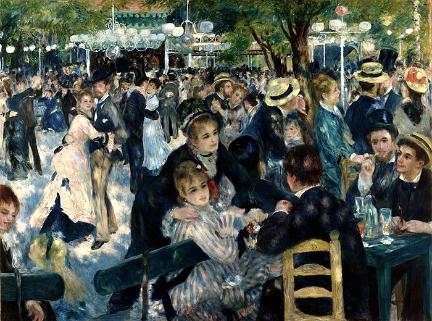
Key Examples and Artists of Impressionism and Photography
The intersection of photography and Impressionist paintingPainting is a fundamental form of visual art that has been practiced for thousands of years. It involves applying pigment to a surface such as canvas, paper, or a wall. Painting can be explored through various styles, techniques, and mediums, each offering unique possibilities for expression and creativity. Historical Background • Ancient Beginnings: The history of painting dates back to More is most evident in the works of key artists. In the following examples, you’ll discover how photographers’ techniques influenced their approaches to capturing movement, light, and composition.
Edgar Degas and Photography
Edgar Degas was profoundly influenced by photography, integrating its techniques into his work. He used cropping and unconventional angles, similar to photographic framing, to create dynamic compositions. Degas’ innovative approach brought a sense of spontaneity and realismRealism is an art movement that emerged in the mid-19th century, emphasizing the depiction of subjects as they appear in everyday life. It rejects the idealized forms and dramatic expressions of Romanticism, focusing instead on accuracy, truthfulness, and the mundane aspects of the human experience. Realism strives to capture the world in a straightforward and unembellished manner. Gustave Courbet, The More to his paintings, mirroring the photographic methods he incorporated.
“The Dance Class”
This paintingPainting is a fundamental form of visual art that has been practiced for thousands of years. It involves applying pigment to a surface such as canvas, paper, or a wall. Painting can be explored through various styles, techniques, and mediums, each offering unique possibilities for expression and creativity. Historical Background • Ancient Beginnings: The history of painting dates back to More captures dancers in mid-movement, highlighting their grace and effort. Degas used light and shadow to convey motion and depth, creating a dynamic and intimate scene. The composition reflects his fascination with capturing fleeting moments, a technique inspired by photography.
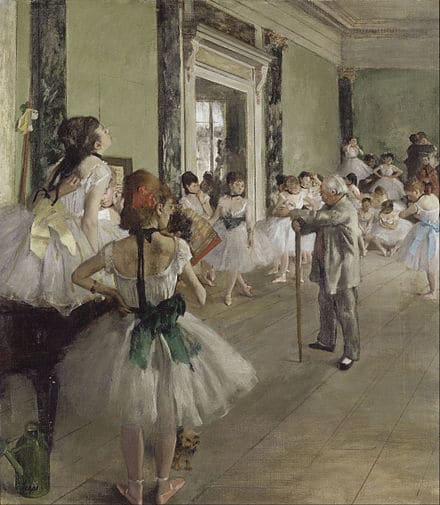
“Racehorses”
In this work, Degas freezes the action of horses in motion, showcasing their power and speed. The piece reflects his study of photographic techniques to understand and depict movement accurately. By focusing on a specific moment in the race, Degas brings a sense of immediacy and excitement to the scene.
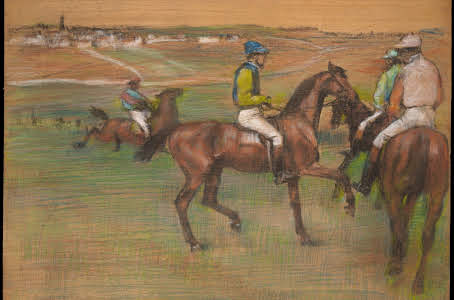
Degas’ work showcases how photography provided new ways to explore and depict the dynamic aspects of these modern times.
Claude Monet and Photography
Claude Monet’s work was deeply influenced by photography, particularly in his approach to capturing light and atmosphere. He often painted the same scene at different times of day to capture varying light conditions, a technique reminiscent of photographic studies. Monet’s innovative use of color and light brought a new depth and realismRealism is an art movement that emerged in the mid-19th century, emphasizing the depiction of subjects as they appear in everyday life. It rejects the idealized forms and dramatic expressions of Romanticism, focusing instead on accuracy, truthfulness, and the mundane aspects of the human experience. Realism strives to capture the world in a straightforward and unembellished manner. Gustave Courbet, The More to his paintings, reflecting his keen observation of the natural world.
“Impression, Sunrise”
This iconic paintingPainting is a fundamental form of visual art that has been practiced for thousands of years. It involves applying pigment to a surface such as canvas, paper, or a wall. Painting can be explored through various styles, techniques, and mediums, each offering unique possibilities for expression and creativity. Historical Background • Ancient Beginnings: The history of painting dates back to More captures the harbor of Le Havre at sunrise, with the sun casting a hazy glow over the water. Monet’s use of loose brushstrokes and vibrant colors creates an impression of the scene rather than a detailed representation. The painting’s atmospheric quality reflects the influence of photography in its focus on light and mood.

“Water Lilies”
Monet’s series of water lilies paintings exemplifies his fascination with capturing the play of light on water. He painted these works at different times of day and in various lighting conditions, much like a photographer would study a subject. The fluid, reflective surfaces and soft colors in these paintings convey a sense of tranquility and depth, influenced by his photographic observations.
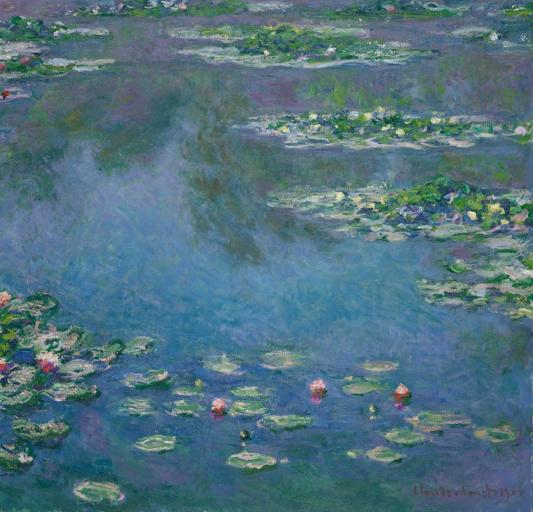
Monet’s work showcases how photography provided new ways to explore the ever-changing aspects of nature.
Berthe Morisot and Photography
Berthe Morisot used photographic framing to create intimate compositions. Her paintings often show private moments with a sense of immediacy. Morisot’s use of light and composition brought a new level of intimacy and realismRealism is an art movement that emerged in the mid-19th century, emphasizing the depiction of subjects as they appear in everyday life. It rejects the idealized forms and dramatic expressions of Romanticism, focusing instead on accuracy, truthfulness, and the mundane aspects of the human experience. Realism strives to capture the world in a straightforward and unembellished manner. Gustave Courbet, The More to her work, highlighting her keen observation of everyday life.
“The Cradle”
This paintingPainting is a fundamental form of visual art that has been practiced for thousands of years. It involves applying pigment to a surface such as canvas, paper, or a wall. Painting can be explored through various styles, techniques, and mediums, each offering unique possibilities for expression and creativity. Historical Background • Ancient Beginnings: The history of painting dates back to More shows a mother watching over her sleeping child, a tender and private moment. Morisot’s use of soft light and careful framing enhances the intimacy of the scene, making the viewer feel as though they are witnessing a personal moment.
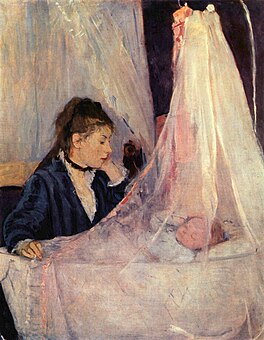
“Young Woman Watering a Shrub”
In this work, Morisot depicts a young woman engaged in a simple, everyday activity. The casual pose and natural light give the paintingPainting is a fundamental form of visual art that has been practiced for thousands of years. It involves applying pigment to a surface such as canvas, paper, or a wall. Painting can be explored through various styles, techniques, and mediums, each offering unique possibilities for expression and creativity. Historical Background • Ancient Beginnings: The history of painting dates back to More a candid, almost photographic quality, highlighting the spontaneity and beauty of daily life.
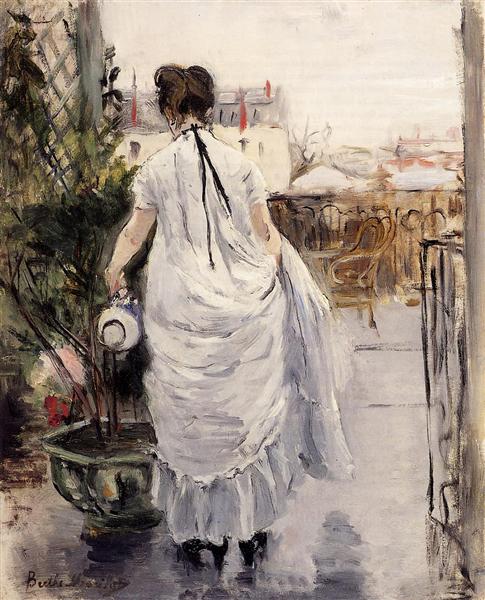
Morisot’s work demonstrates how photography provided new ways to capture the immediacy of personal and domestic scenes.
Mary Cassatt and Photography
Mary Cassatt was heavily influenced by photography in her approach to depicting intimate family moments. Her compositions often use tight framing and unique perspectives, similar to those found in candid photographs. Cassatt’s focus on light and shadow, along with her ability to capture everyday life, brought a new depth to her paintings, emphasizing the personal and emotional aspects of her subjects.
“The Bath”
This paintingPainting is a fundamental form of visual art that has been practiced for thousands of years. It involves applying pigment to a surface such as canvas, paper, or a wall. Painting can be explored through various styles, techniques, and mediums, each offering unique possibilities for expression and creativity. Historical Background • Ancient Beginnings: The history of painting dates back to More shows a mother bathing her child, a tender and intimate moment. Cassatt’s use of light and shadow, along with careful composition, enhances the emotional connection between the figures, making the viewer feel part of the scene.
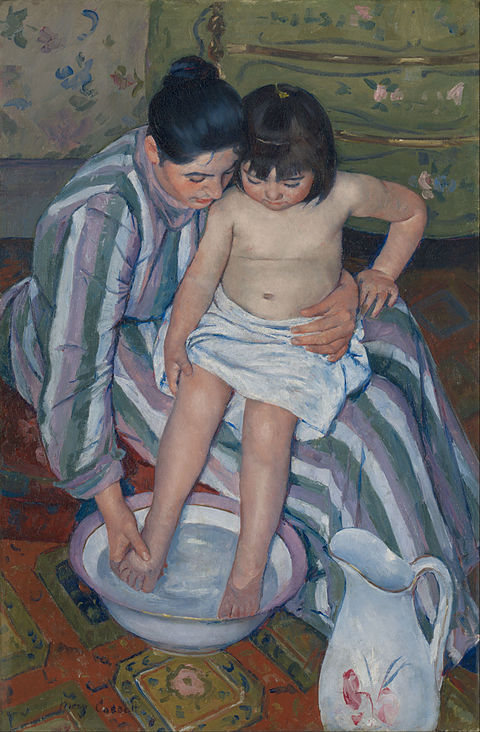
“Little Girl in a Blue Armchair”
In this work, Cassatt shows a young girl lounging casually in a relaxed, natural pose. The composition and light create a sense of immediacy and intimacy, showing Cassatt’s photographic influences.

Cassatt’s work highlights how photography provided new ways to frame and capture the beauty of everyday domestic scenes.
Alfred Sisley and Photography
Alfred Sisley drew significant influence from photography in his portrayal of light and atmosphere. He often painted landscapes with a focus on capturing the transient effects of light, similar to how a photograph freezes a moment. Sisley’s work reflects a keen observation of natural scenes, using light to convey mood and depth. His approach brought a realistic yet poetic quality to his landscapes.
“Flood at Port-Marly”
This paintingPainting is a fundamental form of visual art that has been practiced for thousands of years. It involves applying pigment to a surface such as canvas, paper, or a wall. Painting can be explored through various styles, techniques, and mediums, each offering unique possibilities for expression and creativity. Historical Background • Ancient Beginnings: The history of painting dates back to More shows a flooded street with reflections in the water, capturing the calm yet somber atmosphere. Sisley’s precise use of light and shadow creates a vivid sense of place and time, reminiscent of a photograph.
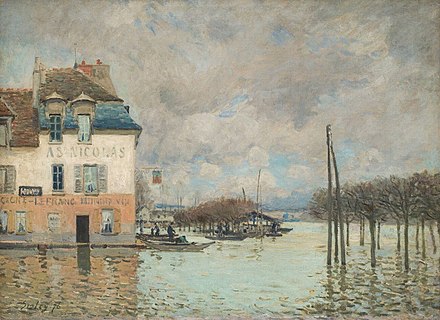
“Snow at Louveciennes”
Sisley portrays a winter scene with a muted color paletteA color palette refers to a selection of colors used in design and art. It can set the tone, convey emotions, and highlight key elements. color wheel Types of Color Palettes • Monochromatic: Uses variations in lightness and saturation of a single color. Ideal for creating a harmonious and cohesive look. • Analogous: Combines colors that are next to each More and soft light. The delicate handling of light and atmosphere provides a serene and realistic depiction of the snowy landscape, showcasing his photographic influence.

Sisley’s work illustrates how photography inspired new ways to depict the natural world with authenticity and emotion.
Camille Pissarro and Photography
Camille Pissarro integrated photographic studies into his portrayal of rural life and landscapes. He often captured the essence of rural scenes, using light and shadow to bring depth and realismRealism is an art movement that emerged in the mid-19th century, emphasizing the depiction of subjects as they appear in everyday life. It rejects the idealized forms and dramatic expressions of Romanticism, focusing instead on accuracy, truthfulness, and the mundane aspects of the human experience. Realism strives to capture the world in a straightforward and unembellished manner. Gustave Courbet, The More to his work. Pissarro’s careful observation of everyday life and natural settings allowed him to infuse his paintings with a sense of authenticity. His approach highlighted the beauty and simplicity of rural existence.
“The Harvest”
This paintingPainting is a fundamental form of visual art that has been practiced for thousands of years. It involves applying pigment to a surface such as canvas, paper, or a wall. Painting can be explored through various styles, techniques, and mediums, each offering unique possibilities for expression and creativity. Historical Background • Ancient Beginnings: The history of painting dates back to More shows farmers working in the fields, reflecting the daily labor of rural life. Pissarro’s use of light and composition emphasizes the harmony between people and nature, much like a well-composed photograph.
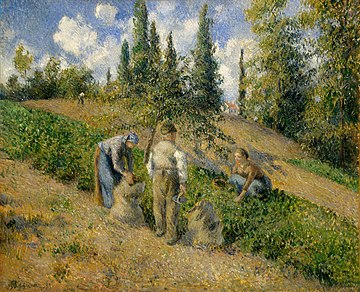
“The Cote des Boeufs at L’Hermitage”
Pissarro presents a peaceful landscape with trees and hills to capture the tranquility of the countryside. The detailed attention to light and atmosphere gives you a realistic sense of the location, influenced by photographic techniques.

Pissarro’s work illustrates how photography inspired new ways to capture the authenticity and beauty of rural landscapes and daily life.
Gustave Caillebotte and Photography
Gustave CaillebotteGustave Caillebotte, a French painter born in 1848, often gets overshadowed by more famous Impressionists like Monet and Renoir. However, his contributions to the movement and his unique approach to painting deserve recognition. Gustave Caillebotte, Self Portrait Early Life and Background • Birth: August 19, 1848, in Paris, France. • Family: Wealthy family involved in textile manufacturing. • Education: Studied More applied photographic perspectives to his paintings of urban life. He often captured Parisian scenes with precision and detail to reflect the influence of photography. Caillebotte’s work shows the bustling energy and architecture of the city. His approach brought a sense of immediacy and realismRealism is an art movement that emerged in the mid-19th century, emphasizing the depiction of subjects as they appear in everyday life. It rejects the idealized forms and dramatic expressions of Romanticism, focusing instead on accuracy, truthfulness, and the mundane aspects of the human experience. Realism strives to capture the world in a straightforward and unembellished manner. Gustave Courbet, The More to his paintings, mirroring the qualities of a photograph.
“Paris Street; Rainy Day”
This paintingPainting is a fundamental form of visual art that has been practiced for thousands of years. It involves applying pigment to a surface such as canvas, paper, or a wall. Painting can be explored through various styles, techniques, and mediums, each offering unique possibilities for expression and creativity. Historical Background • Ancient Beginnings: The history of painting dates back to More shows a busy Parisian street with people walking under umbrellas. Caillebotte’s use of perspective and composition creates a sense of depth and movement, reflecting the influence of photography on his work.

“The Floor Scrapers”
In this work, Caillebotte shows workers refinishing a wooden floor. The precise angles and detailed depiction of the scene highlight his use of photographic techniques to capture urban life with realismRealism is an art movement that emerged in the mid-19th century, emphasizing the depiction of subjects as they appear in everyday life. It rejects the idealized forms and dramatic expressions of Romanticism, focusing instead on accuracy, truthfulness, and the mundane aspects of the human experience. Realism strives to capture the world in a straightforward and unembellished manner. Gustave Courbet, The More and depth.

Caillebotte’s work illustrates how photography inspired new ways to present the complexity and vibrancy of urban environments.
Édouard Manet and Photography
Édouard Manet embraced the influence of candid photographic moments and innovative lighting techniques in his work. He often captured scenes with a spontaneous feel, using natural light to create depth and realismRealism is an art movement that emerged in the mid-19th century, emphasizing the depiction of subjects as they appear in everyday life. It rejects the idealized forms and dramatic expressions of Romanticism, focusing instead on accuracy, truthfulness, and the mundane aspects of the human experience. Realism strives to capture the world in a straightforward and unembellished manner. Gustave Courbet, The More. Manet’s paintings reflect an immediacy and authenticity that align closely with the qualities of photography. His approach brought a modern, fresh perspective to traditional subjects.
“Olympia”
This paintingPainting is a fundamental form of visual art that has been practiced for thousands of years. It involves applying pigment to a surface such as canvas, paper, or a wall. Painting can be explored through various styles, techniques, and mediums, each offering unique possibilities for expression and creativity. Historical Background • Ancient Beginnings: The history of painting dates back to More presents a reclining nude woman, capturing her with stark, direct lighting that adds a sense of realismRealism is an art movement that emerged in the mid-19th century, emphasizing the depiction of subjects as they appear in everyday life. It rejects the idealized forms and dramatic expressions of Romanticism, focusing instead on accuracy, truthfulness, and the mundane aspects of the human experience. Realism strives to capture the world in a straightforward and unembellished manner. Gustave Courbet, The More. The candid, unposed nature of the subject mirrors the influence of photography on Manet’s style.

“A Bar at the Folies-Bergère”
Manet portrays a barmaid in a busy Parisian nightclub. The use of light and reflection creates a complex, layered composition that highlights the candid interactions and vibrant atmosphere typical of a photograph.
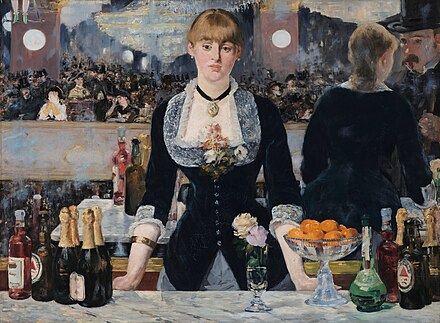
Manet’s work demonstrates how photography inspired new ways to present the immediacy and authenticity of modern life.
Jean-François Raffaëlli and Photography
Jean-François RaffaëlliJean-François Raffaëlli, a French painter born in 1850, is known for his realistic portrayals of urban life and the working class. His detailed and empathetic approach to his subjects has earned him a unique place in art history. Early Life and Background • Birth: April 20, 1850, in Paris, France. • Family: Grew up in a middle-class family with a More was influenced by photographic documentation in his portrayal of social realismRealism is an art movement that emerged in the mid-19th century, emphasizing the depiction of subjects as they appear in everyday life. It rejects the idealized forms and dramatic expressions of Romanticism, focusing instead on accuracy, truthfulness, and the mundane aspects of the human experience. Realism strives to capture the world in a straightforward and unembellished manner. Gustave Courbet, The More. He captured the lives of the working class with detailed and realistic compositions. Raffaëlli’s work reflects the everyday struggles and dignity of his subjects, mirroring the qualities of documentary photography. His approach brought a stark, honest perspective to his paintings.
“The Absinthe Drinkers”
This paintingPainting is a fundamental form of visual art that has been practiced for thousands of years. It involves applying pigment to a surface such as canvas, paper, or a wall. Painting can be explored through various styles, techniques, and mediums, each offering unique possibilities for expression and creativity. Historical Background • Ancient Beginnings: The history of painting dates back to More shows two individuals in a moment of quiet reflection, capturing the hardships of their lives. Raffaëlli’s attention to detail and use of natural light creates a raw, unembellished portrayal of his subjects, akin to a photograph.

“The Outskirts of Paris”
Raffaëlli presents a scene of urban poverty, with detailed attention to the environment and people. The realistic depiction of the setting and the individuals within it highlights the influence of photographic documentation, providing a powerful commentary on social conditions.

Raffaëlli’s work illustrates how photography inspired new ways to portray the reality of social issues and everyday life.
Pierre-Auguste Renoir and Photography
Pierre-Auguste RenoirPierre-Auguste Renoir (1841 – 1919) is one of the last representatives of a tradition that runs directly from Rubens to Watteau. The French artist was a leading painter of the Impressionist art movement, famed for depicting female beauty and charming scenes. Coming from humble beginnings, he became an apprentice to a porcelain painter where he learned to copy designs and More drew inspiration from photography in his portrayal of social interactions and the play of light. He often painted lively gatherings and intimate moments, using natural light to enhance realismRealism is an art movement that emerged in the mid-19th century, emphasizing the depiction of subjects as they appear in everyday life. It rejects the idealized forms and dramatic expressions of Romanticism, focusing instead on accuracy, truthfulness, and the mundane aspects of the human experience. Realism strives to capture the world in a straightforward and unembellished manner. Gustave Courbet, The More. Renoir’s works reflect a vibrant, dynamic quality to capture the essence of human connection and the subtleties of light.
“Luncheon of the Boating Party”
This paintingPainting is a fundamental form of visual art that has been practiced for thousands of years. It involves applying pigment to a surface such as canvas, paper, or a wall. Painting can be explored through various styles, techniques, and mediums, each offering unique possibilities for expression and creativity. Historical Background • Ancient Beginnings: The history of painting dates back to More shows a group of friends enjoying a leisurely meal by the river. Renoir’s use of light and shadow, along with the casual, candid composition, reflects the influence of photography, making the scene feel immediate and alive.
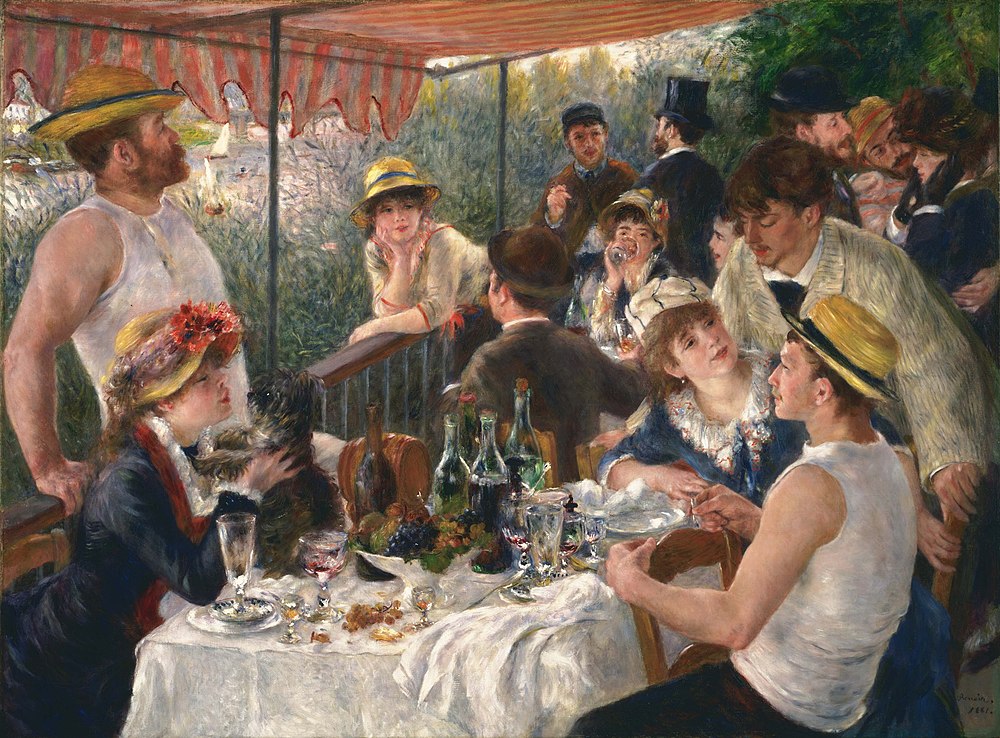
“Dance at Le Moulin de la Galette”
Renoir presents a bustling outdoor dance scene filled with movement and light. The interplay of light filtering through the trees and the spontaneous interactions of the dancers create a vivid, engaging atmosphere, reminiscent of a snapshot in time.

Renoir’s work illustrates how photography inspired new ways to capture the vibrancy of social interactions and the effects of natural light.
Visually Comparing Impressionism to Photography
By comparing photographs with Impressionist paintings side-by-side, we can clearly see the influence of photography on these artists’ techniques and compositions.
1. Paris Street, Rainy Day by Gustave CaillebotteGustave Caillebotte, a French painter born in 1848, often gets overshadowed by more famous Impressionists like Monet and Renoir. However, his contributions to the movement and his unique approach to painting deserve recognition. Gustave Caillebotte, Self Portrait Early Life and Background • Birth: August 19, 1848, in Paris, France. • Family: Wealthy family involved in textile manufacturing. • Education: Studied More and a 19th-century Paris street photograph
- Photograph: A black-and-white photograph of a Paris street.

- PaintingPainting is a fundamental form of visual art that has been practiced for thousands of years. It involves applying pigment to a surface such as canvas, paper, or a wall. Painting can be explored through various styles, techniques, and mediums, each offering unique possibilities for expression and creativity. Historical Background • Ancient Beginnings: The history of painting dates back to More: Caillebotte’s “Paris Street, Rainy Day” translates the photographic perspective and framing into paintingPainting is a fundamental form of visual art that has been practiced for thousands of years. It involves applying pigment to a surface such as canvas, paper, or a wall. Painting can be explored through various styles, techniques, and mediums, each offering unique possibilities for expression and creativity. Historical Background • Ancient Beginnings: The history of painting dates back to More.

- Comparison: Both images emphasize depth and natural light. Caillebotte’s paintingPainting is a fundamental form of visual art that has been practiced for thousands of years. It involves applying pigment to a surface such as canvas, paper, or a wall. Painting can be explored through various styles, techniques, and mediums, each offering unique possibilities for expression and creativity. Historical Background • Ancient Beginnings: The history of painting dates back to More reflects the influence of photography in its realistic depiction of the urban environment.
2. The Ballet Rehearsal by Edgar Degas and a photograph of a ballet class
- Photograph: An image of a ballet class, showing dancers in different poses.
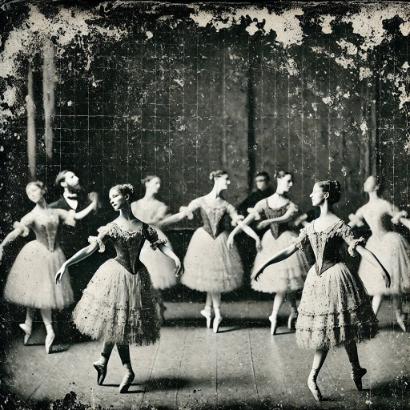
- PaintingPainting is a fundamental form of visual art that has been practiced for thousands of years. It involves applying pigment to a surface such as canvas, paper, or a wall. Painting can be explored through various styles, techniques, and mediums, each offering unique possibilities for expression and creativity. Historical Background • Ancient Beginnings: The history of painting dates back to More: Degas’ “The Dance Class” mirrors the spontaneity and candidness of a photograph.

- Comparison: Both emphasize movement and natural light. Degas’ use of unusual angles and cropping shows the direct influence of photographic techniques.
3. Impression, Sunrise by Claude MonetFrench painter Claude Monet (1840 – 1926) was a key figure of the impressionist movement which started in the second half of the 19th century. During his long career, Monet focused on depicting leisure activities and plein air landscape painting. Born in Paris, his family moved to Le Havre in Normandy when Claude was 5 years old. From early on, More and a photograph of a sunrise over water
- Photograph: A black-and-white photograph of a sunrise.
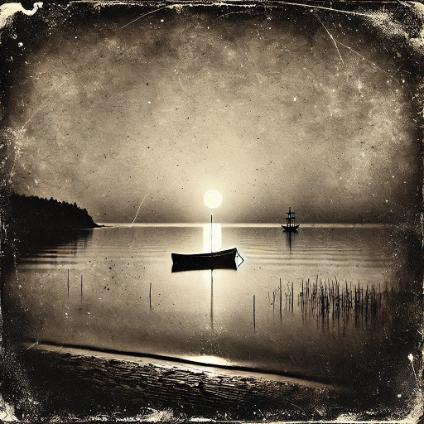
- PaintingPainting is a fundamental form of visual art that has been practiced for thousands of years. It involves applying pigment to a surface such as canvas, paper, or a wall. Painting can be explored through various styles, techniques, and mediums, each offering unique possibilities for expression and creativity. Historical Background • Ancient Beginnings: The history of painting dates back to More: Monet’s “Impression, Sunrise” captures similar lighting and atmospheric effects.
- Comparison: Both works focus on the transient effects of light and color. Monet’s brushstrokes mimic the soft, diffused light as in a photograph, highlighting the influence of photographic studies on his technique.
Through these visual comparisons, we see how photography directly impacted the style and technique of Impressionist paintings, revolutionizing their approach to capturing the world.
Broader Impact of Photography on Art
Photography’s influence extended well beyond ImpressionismImpressionism was an art movement of the 19th century developed in France, based on the practice of painting spontaneously out-doors (“en plein air”) rather than in the studio. Key impressionist subjects were everyday scenes and landscapes, in which the momentary and transient effects of sunlight should be captured. The artists worked directly in front of their subjects, using rapid brushwork More, shaping subsequent art movements like Post-ImpressionismPost-Impressionism is an art movement that emerged in France in the late 19th century, following the close of the Impressionist era. While it retained the vivid color palette and real-life subject matter of Impressionism, Post-Impressionism rejected its limitations by emphasizing a more structured, formal composition and greater emotional depth. This movement was not defined by a single aesthetic but represented More and ModernismThe term Modernism refers to a global movement in society and culture which sought the departure from traditional forms of thinking in favour of the creation of new forms of art, philosophy, and social organisation. Reflecting the transformations in western society during the late 19th and early 20th centuries and the newly emerging industrial world provided the impetus to depart More. Artists in these movements continued to draw from photographic techniques, using light, perspective, and composition to innovate their styles.

Post-Impressionism and Photography
Artists like Vincent van GoghVincent van Gogh (1853 – 1890) is one of the renowned Post-Impressionist artists, best known for his striking use of colour, emphatic brushwork, and contoured forms. As a son of a pastor, the Dutch artist war brought up in a religious and cultured atmosphere. After working unsuccessfully as a clerk at a bookstore, as a salesman, and as a preacher More and Paul CézannePaul Cézanne (1839–1906) is often hailed as the "father of modern art." His pioneering approach to painting laid the groundwork for the transition from 19th-century artistic traditions to the radically different styles of the 20th century. Known for his innovative use of color, brushstrokes, and composition, Cézanne's work profoundly influenced future generations of artists, including the Fauves, Cubists, and Abstract More incorporated photographic realismRealism is an art movement that emerged in the mid-19th century, emphasizing the depiction of subjects as they appear in everyday life. It rejects the idealized forms and dramatic expressions of Romanticism, focusing instead on accuracy, truthfulness, and the mundane aspects of the human experience. Realism strives to capture the world in a straightforward and unembellished manner. Gustave Courbet, The More and unique viewpoints into their work. Van Gogh’s “Starry Night” showcases dynamic light effects inspired by photographic studies. Cézanne used photographs to study perspective and form, which helped him break down objects into basic geometric shapes. This approach laid the groundwork for CubismSynthetic cubism was the later period of the Cubist art movement generally dated from 1912 – 1919. Artists of Synthetic Cubism moved away from the multi-perspective approach of Analytical Cubism in favour of flattened images that dispensed allusions of the three-dimensional space. Pablo Picasso, Clarinet, Bottle of Bass, Newspaper, Ace of Clubs (2013) The approach of the analytical phase was More, influencing artists like Pablo PicassoPablo Picasso (1881–1973), was a Spanish painter, sculptor, graphic artist, and resident in France from 1904. He was a dominant figure in avant-garde movements in the first half of the 20th century due to his technical versatility and prolific inventiveness. picasso-self-portrait Picasso’s progression in his early work is largely categorized by predominant colour schemes: His Blue Period (1901-1904) features motifs More.

Modernism and Photography
Photographers and painters like Edward Hopper and Georgia O’Keeffe explored new perspectives and compositions. Hopper’s “Nighthawks” captures a candid moment in urban life, reflecting photographic influence in its framing and use of light. O’Keeffe’s close-up flower paintings, such as “Black Iris,” show how photographic techniques can transform ordinary subjects into abstract forms.

Impact of Photography on Techniques and Composition
Photography’s influence on techniques and composition led artists to rethink their approach to light, perspective, and subject matter.
Use of Light and Shadow in Photography
Photographic studies of light and shadow informed many Modernist works. Artists like Henri Cartier-Bresson applied these techniques in street photography, emphasizing the interplay of light and darkness. Painters adopted these principles to enhance realismRealism is an art movement that emerged in the mid-19th century, emphasizing the depiction of subjects as they appear in everyday life. It rejects the idealized forms and dramatic expressions of Romanticism, focusing instead on accuracy, truthfulness, and the mundane aspects of the human experience. Realism strives to capture the world in a straightforward and unembellished manner. Gustave Courbet, The More and depth in their work. For example, Edward Hopper’s “Nighthawks” uses dramatic light and shadow to create mood and focus, while Georges Braque’s “Houses at L’Estaque” applies light and shadow to emphasize form and structure.

Exploration of Movement through Photography
Photography’s ability to freeze motion influenced artists to explore dynamic compositions. The Futurists, for example, used photographic techniques to convey movement and energy. Giacomo Balla’s “Dynamism of a Dog on a Leash” captures the rapid movement of a dog, illustrating the impact of photographic motion studies on paintingPainting is a fundamental form of visual art that has been practiced for thousands of years. It involves applying pigment to a surface such as canvas, paper, or a wall. Painting can be explored through various styles, techniques, and mediums, each offering unique possibilities for expression and creativity. Historical Background • Ancient Beginnings: The history of painting dates back to More. Marcel Duchamp’s “Nude Descending a Staircase, No. 2” also demonstrates this influence with its depiction of movement through fragmented and overlapping forms.
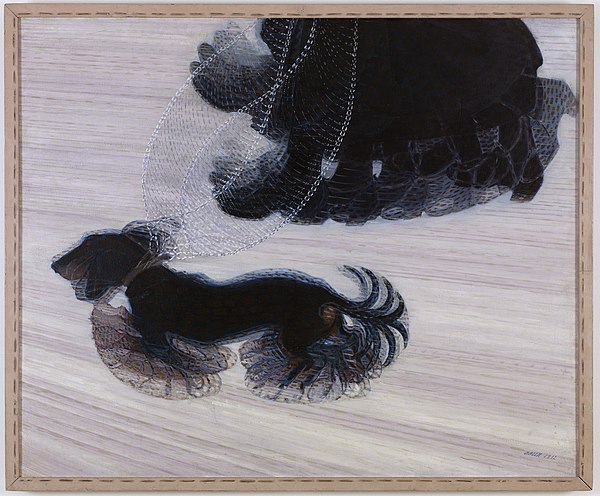
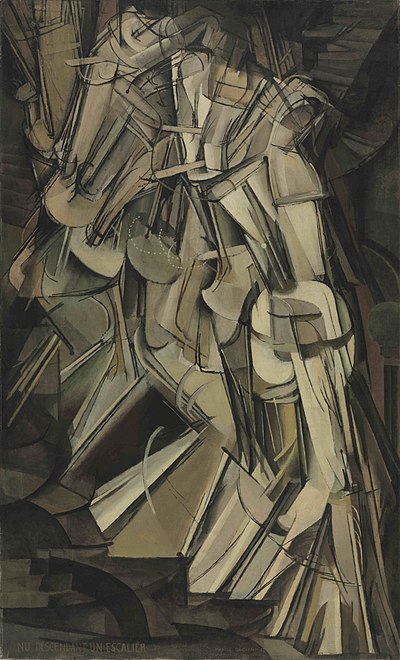
Continuing Influence of Photography
Photography’s impact on art did not end with ImpressionismImpressionism was an art movement of the 19th century developed in France, based on the practice of painting spontaneously out-doors (“en plein air”) rather than in the studio. Key impressionist subjects were everyday scenes and landscapes, in which the momentary and transient effects of sunlight should be captured. The artists worked directly in front of their subjects, using rapid brushwork More. It continues to shape contemporary art practices. Digital photography and photo manipulation techniques offer new tools for artists, blending traditional methods with modern technology. This ongoing relationship between photography and art ensures that the innovations started by the Impressionists will continue to evolve and inspire future generations.

Sources
Daniel, M. (2004). Daguerre (1787–1851) and the Invention of Photography. Heilbrunn Timeline of Art History, The Metropolitan Museum of Art. Retrieved from https://www.metmuseum.org/toah/hd/dagu/hd_dagu.htm
Department of Photographs. (2004). The Daguerreian Era and Early American Photography on Paper, 1839–60. Heilbrunn Timeline of Art History, The Metropolitan Museum of Art. Retrieved from https://www.metmuseum.org/toah/hd/adag/hd_adag.htm
Daniel, M. (2004). William Henry Fox Talbot (1800–1877) and the Invention of Photography. Heilbrunn Timeline of Art History, The Metropolitan Museum of Art. Retrieved from https://www.metmuseum.org/toah/hd/tlbt/hd_tlbt.htm
Daniel, M. (2008). The Rise of Paper Photography in 1850s France. Heilbrunn Timeline of Art History, The Metropolitan Museum of Art. Retrieved from https://www.metmuseum.org/toah/hd/frph/hd_frph.htm
Eklund, D. (2004). Art and Photography: The 1980s. Heilbrunn Timeline of Art History, The Metropolitan Museum of Art. Retrieved from https://www.metmuseum.org/toah/hd/ap80/hd_ap80.htm
The Art Story Foundation. (2023). ImpressionismImpressionism was an art movement of the 19th century developed in France, based on the practice of painting spontaneously out-doors (“en plein air”) rather than in the studio. Key impressionist subjects were everyday scenes and landscapes, in which the momentary and transient effects of sunlight should be captured. The artists worked directly in front of their subjects, using rapid brushwork More and Photography. Retrieved from https://www.theartstory.org/movement/impressionism/
Smarthistory. (2023). ImpressionismImpressionism was an art movement of the 19th century developed in France, based on the practice of painting spontaneously out-doors (“en plein air”) rather than in the studio. Key impressionist subjects were everyday scenes and landscapes, in which the momentary and transient effects of sunlight should be captured. The artists worked directly in front of their subjects, using rapid brushwork More: Art and Modernity. Retrieved from https://smarthistory.org/painting-modern-life/
Tate. (2023). How Did Photography Influence ImpressionismImpressionism was an art movement of the 19th century developed in France, based on the practice of painting spontaneously out-doors (“en plein air”) rather than in the studio. Key impressionist subjects were everyday scenes and landscapes, in which the momentary and transient effects of sunlight should be captured. The artists worked directly in front of their subjects, using rapid brushwork More?. Retrieved from https://www.tate.org.uk/art/art-terms/i/impressionism
National Gallery of Art. (2023). The Influence of Photography on ImpressionismImpressionism was an art movement of the 19th century developed in France, based on the practice of painting spontaneously out-doors (“en plein air”) rather than in the studio. Key impressionist subjects were everyday scenes and landscapes, in which the momentary and transient effects of sunlight should be captured. The artists worked directly in front of their subjects, using rapid brushwork More. Retrieved from https://www.nga.gov/exhibitions/2024/paris-1874-impressionist-moment.html
Institute for Advanced Study. (2023). PaintingPainting is a fundamental form of visual art that has been practiced for thousands of years. It involves applying pigment to a surface such as canvas, paper, or a wall. Painting can be explored through various styles, techniques, and mediums, each offering unique possibilities for expression and creativity. Historical Background • Ancient Beginnings: The history of painting dates back to More Time: ImpressionismImpressionism was an art movement of the 19th century developed in France, based on the practice of painting spontaneously out-doors (“en plein air”) rather than in the studio. Key impressionist subjects were everyday scenes and landscapes, in which the momentary and transient effects of sunlight should be captured. The artists worked directly in front of their subjects, using rapid brushwork More and Modern Temporal Order. Retrieved from https://www.ias.edu/ideas/2013/dombrowski-time
History Cooperative. (2023). How ImpressionismImpressionism was an art movement of the 19th century developed in France, based on the practice of painting spontaneously out-doors (“en plein air”) rather than in the studio. Key impressionist subjects were everyday scenes and landscapes, in which the momentary and transient effects of sunlight should be captured. The artists worked directly in front of their subjects, using rapid brushwork More Revolutionized the Art World. Retrieved from https://historycooperative.org/journal/a-lasting-impression-french-painters-revolutionize-the-art-world/
USEUM. (2023). Early Criticism of ImpressionismImpressionism was an art movement of the 19th century developed in France, based on the practice of painting spontaneously out-doors (“en plein air”) rather than in the studio. Key impressionist subjects were everyday scenes and landscapes, in which the momentary and transient effects of sunlight should be captured. The artists worked directly in front of their subjects, using rapid brushwork More. Retrieved from https://useum.org/exhibition/curated/Impressionism/Early-Criticism
Britannica. (2023). ImpressionismImpressionism was an art movement of the 19th century developed in France, based on the practice of painting spontaneously out-doors (“en plein air”) rather than in the studio. Key impressionist subjects were everyday scenes and landscapes, in which the momentary and transient effects of sunlight should be captured. The artists worked directly in front of their subjects, using rapid brushwork More: Art History. Retrieved from https://www.britannica.com/art/Impressionism-art
University of Michigan Arts & Culture. (2023). Reexamining the Link Between the Rise of Photography and ImpressionismImpressionism was an art movement of the 19th century developed in France, based on the practice of painting spontaneously out-doors (“en plein air”) rather than in the studio. Key impressionist subjects were everyday scenes and landscapes, in which the momentary and transient effects of sunlight should be captured. The artists worked directly in front of their subjects, using rapid brushwork More. Retrieved from https://arts.umich.edu/news-features/reexamining-link-between-rise-of-photography-and-impressionism/
Alarcó, P. (2020). The Impressionists and Photography. Yale University Press.
McNamara, C. (2009). The Lens of ImpressionismImpressionism was an art movement of the 19th century developed in France, based on the practice of painting spontaneously out-doors (“en plein air”) rather than in the studio. Key impressionist subjects were everyday scenes and landscapes, in which the momentary and transient effects of sunlight should be captured. The artists worked directly in front of their subjects, using rapid brushwork More: Photography and PaintingPainting is a fundamental form of visual art that has been practiced for thousands of years. It involves applying pigment to a surface such as canvas, paper, or a wall. Painting can be explored through various styles, techniques, and mediums, each offering unique possibilities for expression and creativity. Historical Background • Ancient Beginnings: The history of painting dates back to More Along the Normandy Coast, 1850-1874. University of Michigan Press.
Herbert, R. L. (1988). ImpressionismImpressionism was an art movement of the 19th century developed in France, based on the practice of painting spontaneously out-doors (“en plein air”) rather than in the studio. Key impressionist subjects were everyday scenes and landscapes, in which the momentary and transient effects of sunlight should be captured. The artists worked directly in front of their subjects, using rapid brushwork More: Art, Leisure, and Parisian Society. Yale University Press.
Heine, F. (2023). ImpressionismImpressionism was an art movement of the 19th century developed in France, based on the practice of painting spontaneously out-doors (“en plein air”) rather than in the studio. Key impressionist subjects were everyday scenes and landscapes, in which the momentary and transient effects of sunlight should be captured. The artists worked directly in front of their subjects, using rapid brushwork More: Masters of Art. Prestel.
Willsdon, C. (2016). In the Gardens of ImpressionismImpressionism was an art movement of the 19th century developed in France, based on the practice of painting spontaneously out-doors (“en plein air”) rather than in the studio. Key impressionist subjects were everyday scenes and landscapes, in which the momentary and transient effects of sunlight should be captured. The artists worked directly in front of their subjects, using rapid brushwork More. Thames & Hudson.
Brodskaïa, N. (2013). ImpressionismImpressionism was an art movement of the 19th century developed in France, based on the practice of painting spontaneously out-doors (“en plein air”) rather than in the studio. Key impressionist subjects were everyday scenes and landscapes, in which the momentary and transient effects of sunlight should be captured. The artists worked directly in front of their subjects, using rapid brushwork More and Post-ImpressionismPost-Impressionism is an art movement that emerged in France in the late 19th century, following the close of the Impressionist era. While it retained the vivid color palette and real-life subject matter of Impressionism, Post-Impressionism rejected its limitations by emphasizing a more structured, formal composition and greater emotional depth. This movement was not defined by a single aesthetic but represented More (Essential). Parkstone International.
Spate, V. (2001). The Colour of Time: Claude MonetFrench painter Claude Monet (1840 – 1926) was a key figure of the impressionist movement which started in the second half of the 19th century. During his long career, Monet focused on depicting leisure activities and plein air landscape painting. Born in Paris, his family moved to Le Havre in Normandy when Claude was 5 years old. From early on, More. Thames & Hudson.
Groom, G. (2012). ImpressionismImpressionism was an art movement of the 19th century developed in France, based on the practice of painting spontaneously out-doors (“en plein air”) rather than in the studio. Key impressionist subjects were everyday scenes and landscapes, in which the momentary and transient effects of sunlight should be captured. The artists worked directly in front of their subjects, using rapid brushwork More, Fashion, and Modernity. Yale University Press.
House, J. (2004). Monet: Nature into Art. Yale University Press.
Gordon, R., & Forge, A. (1988). Degas. Harry N. Abrams.
Distel, A. (1990). Renoir. Abbeville Press.
Dumas, A. (2015). The Private Lives of the Impressionists. Harper Perennial.
Quick Facts and FAQ
Q: How did photography influence the Impressionists?
A: Photography influenced the Impressionists by introducing new ways of seeing and capturing light and movement. Artists began to adopt techniques like cropping and unusual perspectives, reflecting photographic compositions. This shift helped create more dynamic and immediate visual experiences. Ultimately, photography encouraged Impressionists to explore everyday moments with greater spontaneity.
Q: What is photo impressionismImpressionism was an art movement of the 19th century developed in France, based on the practice of painting spontaneously out-doors (“en plein air”) rather than in the studio. Key impressionist subjects were everyday scenes and landscapes, in which the momentary and transient effects of sunlight should be captured. The artists worked directly in front of their subjects, using rapid brushwork More?
A: Photo impressionismImpressionism was an art movement of the 19th century developed in France, based on the practice of painting spontaneously out-doors (“en plein air”) rather than in the studio. Key impressionist subjects were everyday scenes and landscapes, in which the momentary and transient effects of sunlight should be captured. The artists worked directly in front of their subjects, using rapid brushwork More refers to a style of photography that mimics the characteristics of Impressionist paintings. This includes the use of soft focus, vibrant colors, and an emphasis on light and atmosphere. It often captures scenes in a way that evokes a painterly quality. This approach blurs the lines between traditional photography and Impressionist art.
Q: How did photography impact the Industrial Revolution?
A: Photography impacted the Industrial Revolution by documenting and promoting the changes and advancements of the era. It provided a visual record of industrial progress, from machinery to urbanization. This new visual medium helped spread information and ideas more quickly. Additionally, photography influenced public perception and awareness of industrial growth.
Q: Did photography affect ImpressionismImpressionism was an art movement of the 19th century developed in France, based on the practice of painting spontaneously out-doors (“en plein air”) rather than in the studio. Key impressionist subjects were everyday scenes and landscapes, in which the momentary and transient effects of sunlight should be captured. The artists worked directly in front of their subjects, using rapid brushwork More?
A: Yes, photography significantly affected ImpressionismImpressionism was an art movement of the 19th century developed in France, based on the practice of painting spontaneously out-doors (“en plein air”) rather than in the studio. Key impressionist subjects were everyday scenes and landscapes, in which the momentary and transient effects of sunlight should be captured. The artists worked directly in front of their subjects, using rapid brushwork More. It introduced new compositional techniques and ways of capturing light that Impressionist painters adopted. The ability to freeze moments in time inspired artists to depict more spontaneous and everyday scenes. Photography also pushed artists to experiment with new perspectives and framing methods.
Q: How did photography shape Impressionist techniques?
A: Photography shaped Impressionist techniques by introducing new ways to study light and movement. Artists began to use photographic methods like unusual angles and cropping in their paintings. This led to more dynamic and immediate compositions. Photography also allowed Impressionists to capture fleeting moments and the effects of natural light more accurately.
Q: How did 19th-century photography influence Impressionist art?
A: 19th-century photography influenced Impressionist art by changing how artists viewed and depicted the world. Photographic techniques such as capturing light and movement were adopted by painters. This led to more realistic and immediate representations of everyday life. Photography also introduced new ways to frame and compose scenes, enhancing the visual impact of paintings.
Q: What is impressionism-inspired photography?
A: Impressionism-inspired photography captures images that reflect the aesthetic and techniques of Impressionist paintings. This style emphasizes light, color, and atmosphere, often with a soft, ethereal quality. Photographers aim to evoke the mood and emotion of a scene rather than focusing on sharp details. This approach creates a dreamy, painterly effect in photographs.
Q: How did photographic advances affect Impressionist art?
A: Photographic advances affected Impressionist art by providing new methods for studying and depicting light and motion. Artists could observe and replicate the effects of natural light more accurately. Photography also introduced new compositional techniques, such as cropping and unusual perspectives. These innovations helped Impressionists create more dynamic and immediate works.
Q: What is abstract impressionismImpressionism was an art movement of the 19th century developed in France, based on the practice of painting spontaneously out-doors (“en plein air”) rather than in the studio. Key impressionist subjects were everyday scenes and landscapes, in which the momentary and transient effects of sunlight should be captured. The artists worked directly in front of their subjects, using rapid brushwork More photography?
A: Abstract impressionismImpressionism was an art movement of the 19th century developed in France, based on the practice of painting spontaneously out-doors (“en plein air”) rather than in the studio. Key impressionist subjects were everyday scenes and landscapes, in which the momentary and transient effects of sunlight should be captured. The artists worked directly in front of their subjects, using rapid brushwork More photography blends elements of abstract art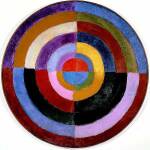 Abstract artworks diverge from depicting recognizable scenes or objects and instead use colors, forms, and lines to create compositions that exist independently of visual references from the natural world. This movement, which gained momentum in the early 20th century, was propelled by artists such as Wassily Kandinsky, Piet Mondrian, and Kazimir Malevich. These artists aimed to explore spiritual, emotional, and More with the techniques of Impressionist paintingPainting is a fundamental form of visual art that has been practiced for thousands of years. It involves applying pigment to a surface such as canvas, paper, or a wall. Painting can be explored through various styles, techniques, and mediums, each offering unique possibilities for expression and creativity. Historical Background • Ancient Beginnings: The history of painting dates back to More. This style focuses on capturing the essence of a scene through light, color, and form rather than detailed representation. Photographers use techniques like blurring and multiple exposures to create abstract, painterly images. This approach emphasizes mood and emotion over realismRealism is an art movement that emerged in the mid-19th century, emphasizing the depiction of subjects as they appear in everyday life. It rejects the idealized forms and dramatic expressions of Romanticism, focusing instead on accuracy, truthfulness, and the mundane aspects of the human experience. Realism strives to capture the world in a straightforward and unembellished manner. Gustave Courbet, The More.
Abstract artworks diverge from depicting recognizable scenes or objects and instead use colors, forms, and lines to create compositions that exist independently of visual references from the natural world. This movement, which gained momentum in the early 20th century, was propelled by artists such as Wassily Kandinsky, Piet Mondrian, and Kazimir Malevich. These artists aimed to explore spiritual, emotional, and More with the techniques of Impressionist paintingPainting is a fundamental form of visual art that has been practiced for thousands of years. It involves applying pigment to a surface such as canvas, paper, or a wall. Painting can be explored through various styles, techniques, and mediums, each offering unique possibilities for expression and creativity. Historical Background • Ancient Beginnings: The history of painting dates back to More. This style focuses on capturing the essence of a scene through light, color, and form rather than detailed representation. Photographers use techniques like blurring and multiple exposures to create abstract, painterly images. This approach emphasizes mood and emotion over realismRealism is an art movement that emerged in the mid-19th century, emphasizing the depiction of subjects as they appear in everyday life. It rejects the idealized forms and dramatic expressions of Romanticism, focusing instead on accuracy, truthfulness, and the mundane aspects of the human experience. Realism strives to capture the world in a straightforward and unembellished manner. Gustave Courbet, The More.
Q: How did Impressionist painters use photographic techniques?
A: Impressionist painters used photographic techniques by incorporating methods such as cropping, unusual angles, and capturing natural light. These techniques helped create more immediate and dynamic compositions. Artists like Degas and Caillebotte were particularly influenced by photography, using it to study movement and everyday scenes. This integration led to a more realistic and spontaneous portrayal of subjects.
Q: How did photography influence Impressionist landscape paintingLandscape painting focuses on the depiction of natural scenery such as mountains, valleys, trees, rivers, and forests. It has been a significant genre in art history, evolving through various styles and periods. Landscape painting captures the beauty of the natural world and often reflects the cultural and philosophical views of the time. JMW Turner, Calais Pier, 1801 Historical Context Landscape More?
A: Photography influenced Impressionist landscape paintingLandscape painting focuses on the depiction of natural scenery such as mountains, valleys, trees, rivers, and forests. It has been a significant genre in art history, evolving through various styles and periods. Landscape painting captures the beauty of the natural world and often reflects the cultural and philosophical views of the time. JMW Turner, Calais Pier, 1801 Historical Context Landscape More by providing new ways to capture natural light and movement. Artists began to use photographic techniques like unusual angles and cropping to create more dynamic compositions. The ability to study light in photographs helped painters depict it more accurately. This led to more realistic and immediate representations of landscapes.
Q: How did photography inspire Impressionist portrait paintingPainting is a fundamental form of visual art that has been practiced for thousands of years. It involves applying pigment to a surface such as canvas, paper, or a wall. Painting can be explored through various styles, techniques, and mediums, each offering unique possibilities for expression and creativity. Historical Background • Ancient Beginnings: The history of painting dates back to More?
A: Photography inspired Impressionist portrait paintingPainting is a fundamental form of visual art that has been practiced for thousands of years. It involves applying pigment to a surface such as canvas, paper, or a wall. Painting can be explored through various styles, techniques, and mediums, each offering unique possibilities for expression and creativity. Historical Background • Ancient Beginnings: The history of painting dates back to More by introducing new ways to capture light and natural expressions. Artists began to use photographic techniques like close-ups and candid poses to create more intimate portraits. This approach allowed for a more realistic and spontaneous depiction of subjects. Photography also helped artists study the effects of light and shadow on the human face, enhancing their work.
You might also enjoy reading the following articles by Pigment Pool:
Difference between Impressionism and Post-Impressionism: Art History Insights
Impressionism and Japonisme: How Japan Has Inspired Western Artists
Trailblazing Pop Art: Female Artists from Iconic Pioneers to Emerging Voices
The Psychology of Colour in Art: Masterpieces and Mind Games
The Best Watercolor Paint Set for Artists and Hobbyists In 2024
The Best Acrylic Paint Set for Artists and Hobbyists In 2024
This article may contain compensated links. Please read Disclaimer for more info. As an Amazon Associate, I earn from qualifying purchases.
